Creating Kanban Views
Kanban view is a card-based view that displays the data in an organized manner for better comprehension. For example, you can segregate the leads based on their status or categorize the sales depending on different stages. This sort of information gives better insights about the potential bottlenecks and lets you fix them effectively.
Below is an instance, where the leads are listed down based on their current state along with their probable revenues. The information is displayed in two ways: List View and Kanban View.

In comparison to List View, where all the records are listed one after the other, a Kanban view segregates your data based upon the lead status giving a clearer picture. You can also view the aggregate revenue under each status. You can create such kanban views for all modules except Tasks, Calls, Meetings, Visits, Finances. There are two types of Kanban views in Zoho CRM: Pre-defined and Customizable.
A) Pre-defined – Pre-defined kanban views are available for Task, Calls, Meetings, Social, Visits, Deals, and SalesInbox and can be viewed by users in all the editions. Below is the CRM view for Task, Calls, Meetings(Activities) modules that are categorized based on Customers, Open Deals, Leads/Contacts and Others.
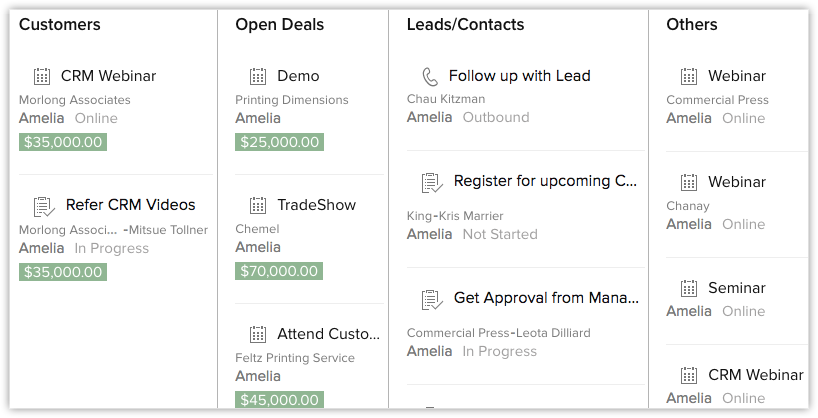
B) Customizable – You can create a customized Kanban view for any module. To create a kanban view you have to enter the following details:
- Kanban View name - You can enter any name for the kanban view created, for example, "Lead Details".
- Categorize by - Select the category in which you want to segregate the data, for example "Lead Status".
- Aggregate by - Select a currency for which you want the aggregated value. For example "Expected revenue, cost per conversion, cost per click etc. ". A summed up value for each category will be displayed.
- Select Fields - Select the fields that you want to view within each record.
- Header style - Choose mono color or random colors for the headers.
Below is a kanban view for the Leads module, here the records are arranged into columns and each lead displays a few related information. The leads are categorized based on three different statuses: attempted to contact, contact in future and contacted. Further, you can view the fields like, industry and annual revenue of each of the leads. The aggregated revenue from the leads is displayed at the top of the respective columns.
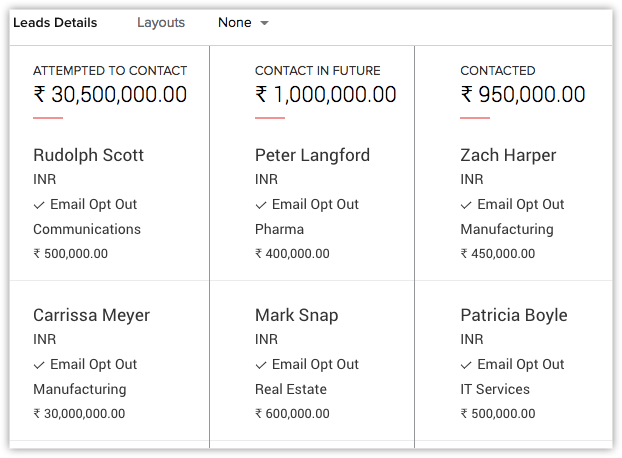
Create a Kanban View
Creating a kanban view will give you precise information about all the records at one click. You can create a kanban view for all the modules except Task, Calls, Meetings (Activities) , Visits and Finances.
To create kanban view
- In Zoho CRM, go to a Module.
- In the Module page, click the Kanban View icon.

- In the Kanban View Settings pop-up, fill the following details:
a) Kanban View Name
b) Categorized By
c) Aggregate By
d) Select Fields - Click Save.
Edit Kanban Settings
After you create kanban view for a module, you can either add or delete the information based on your requirement.
To edit the kanban settings
- In the Modules page, click Kanban View Settings.
- In the pop-up, edit the details.
- Click Save.
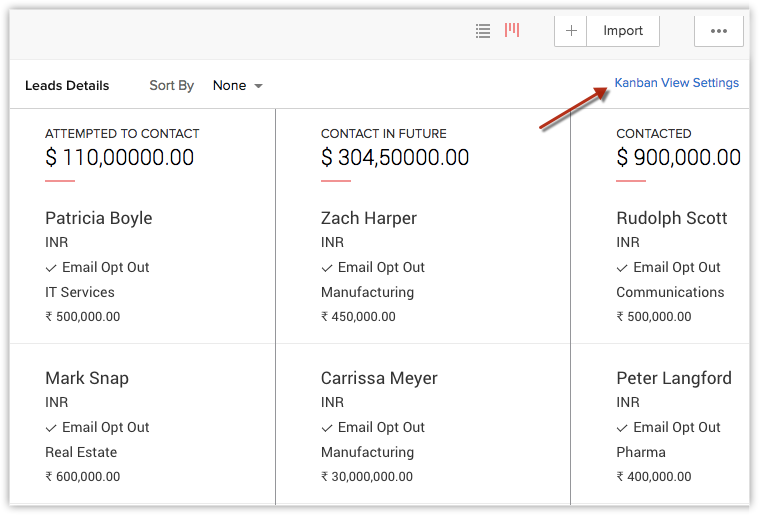

- The Kanban view settings option is enabled only if the picklist fields are available in the selected module.
Working with Kanban View
In addition to viewing the record details in an organized manner you can perform several other operations from the kanban view. Let us take a look at each of them:
- Drag and Drop - You can drag and drop a record from one column to another based on the requirement. For instance, a lead listed under "attempted to contact" has declined the present offer and you want to keep them in pipeline for future reference. So, instead of editing the record and changing the status you can simply drag and drop the record to the desired column to automatically change the status. Also, the aggregated value of the respective column will get updated.
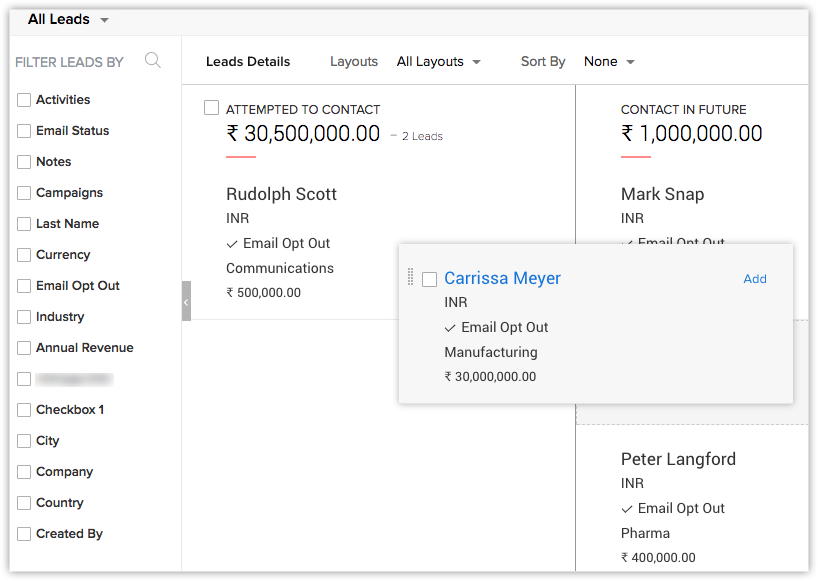
- Mass Operations - You can send mass emails, create tasks, create macros and so on. From the More Actions icon, you can change owner, mass update a field, mass convert the leads or delete leads.
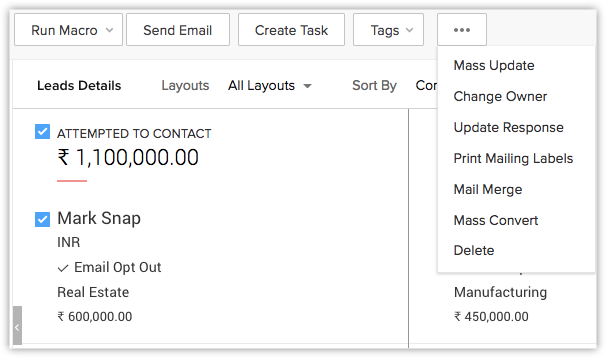
- Select a Layout - A user can select a layout in which they want to view the module.
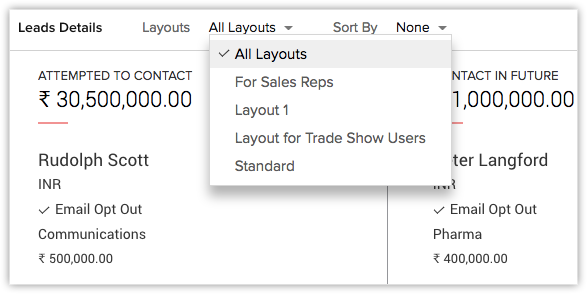
- Sort Records - A user can sort the records based on the fields they want to view like company, first name, last name, lead owner and so on.
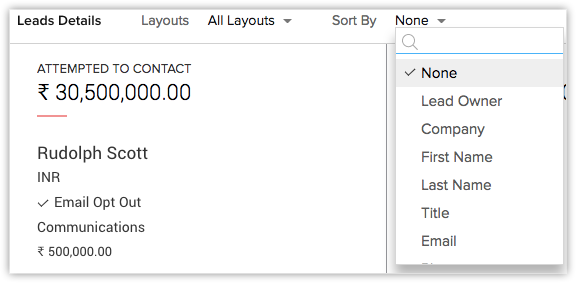
Related Articles
Can I perform bulk operations in Kanban View?
Yes, you can perform the following bulk operations: Sending mass emails Creating tasks Creating macros Deleting records Changing owner Mass updating a field Mass conversion To perform a mass operation, select multiple records, click the More icon, ...What are the predefined and customizable Kanban views?
There are two types of Kanban views: Predefined: Predefined kanban views are available for the Social, Visits, Deals, and SalesInbox modules and are available in all editions. Customizable: You can create a Kanban view for other modules. You will ...What are the benefits of Kanban view?
The Kanban view is a card-based view that displays records in different categories. The user can choose the criteria for the categories. For example, customers can be segregated based on the industry they belong to or the type of product they want to ...What does the Unaccounted column in the Kanban view mean?
The records that don't have a value in the picklist field that is selected to categorize the Kanban view will be listed in the Unaccounted column. This can also happen if the picklist value for a record is changed to "None". For example: If the value ...How do I segregate leads using the Kanban view and how can I customize the view?
Kanban view segregates records based on a picklist value. For example, if you get leads from different sources and have added Lead Source as a picklist field in the module, you can select this field so that the leads are categorized based on their ...